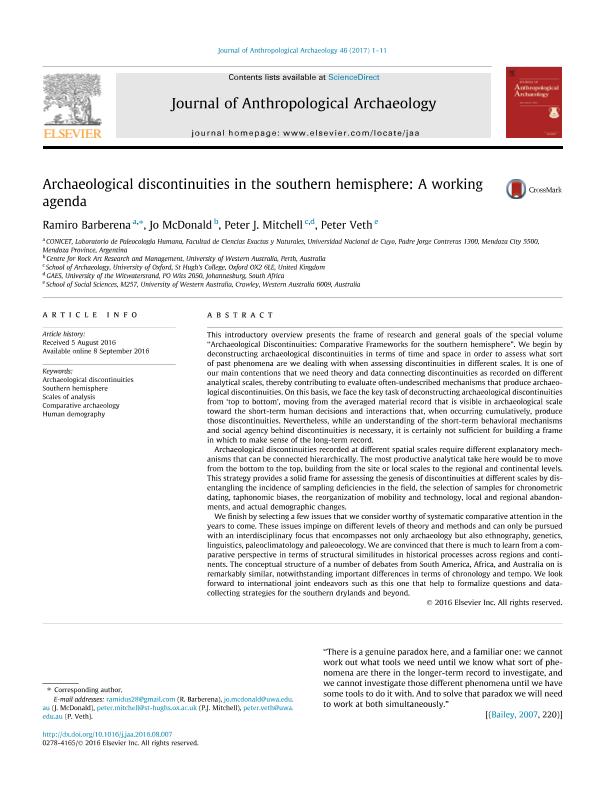Mostrar el registro sencillo del ítem
dc.contributor.author
Barberena, Ramiro

dc.contributor.author
McDonald, Jo
dc.contributor.author
Mitchell, Peter J.
dc.contributor.author
Veth, Peter

dc.date.available
2018-12-21T17:29:12Z
dc.date.issued
2017-06
dc.identifier.citation
Barberena, Ramiro; McDonald, Jo; Mitchell, Peter J.; Veth, Peter; Archaeological discontinuities in the southern hemisphere: A working agenda; Academic Press Inc.; Journal of Anthropological Archaeology; 46; 6-2017; 1-11
dc.identifier.issn
1090-2686
dc.identifier.uri
http://hdl.handle.net/11336/66909
dc.description.abstract
This introductory overview presents the frame of research and general goals of the special volume “Archaeological Discontinuities: Comparative Frameworks for the southern hemisphere”. We begin by deconstructing archaeological discontinuities in terms of time and space in order to assess what sort of past phenomena are we dealing with when assessing discontinuities in different scales. It is one of our main contentions that we need theory and data connecting discontinuities as recorded on different analytical scales, thereby contributing to evaluate often-undescribed mechanisms that produce archaeological discontinuities. On this basis, we face the key task of deconstructing archaeological discontinuities from ‘top to bottom’, moving from the averaged material record that is visible in archaeological scale toward the short-term human decisions and interactions that, when occurring cumulatively, produce those discontinuities. Nevertheless, while an understanding of the short-term behavioral mechanisms and social agency behind discontinuities is necessary, it is certainly not sufficient for building a frame in which to make sense of the long-term record. Archaeological discontinuities recorded at different spatial scales require different explanatory mechanisms that can be connected hierarchically. The most productive analytical take here would be to move from the bottom to the top, building from the site or local scales to the regional and continental levels. This strategy provides a solid frame for assessing the genesis of discontinuities at different scales by disentangling the incidence of sampling deficiencies in the field, the selection of samples for chronometric dating, taphonomic biases, the reorganization of mobility and technology, local and regional abandonments, and actual demographic changes. We finish by selecting a few issues that we consider worthy of systematic comparative attention in the years to come. These issues impinge on different levels of theory and methods and can only be pursued with an interdisciplinary focus that encompasses not only archaeology but also ethnography, genetics, linguistics, paleoclimatology and paleoecology. We are convinced that there is much to learn from a comparative perspective in terms of structural similitudes in historical processes across regions and continents. The conceptual structure of a number of debates from South America, Africa, and Australia on is remarkably similar, notwithstanding important differences in terms of chronology and tempo. We look forward to international joint endeavors such as this one that help to formalize questions and data-collecting strategies for the southern drylands and beyond.
dc.format
application/pdf
dc.language.iso
eng
dc.publisher
Academic Press Inc.
dc.rights
info:eu-repo/semantics/openAccess
dc.rights.uri
https://creativecommons.org/licenses/by-nc-sa/2.5/ar/
dc.subject
Archaeological Discontinuities
dc.subject
Comparative Archaeology
dc.subject
Human Demography
dc.subject
Scales of Analysis
dc.subject
Southern Hemisphere
dc.subject.classification
Historia

dc.subject.classification
Historia y Arqueología

dc.subject.classification
HUMANIDADES

dc.title
Archaeological discontinuities in the southern hemisphere: A working agenda
dc.type
info:eu-repo/semantics/article
dc.type
info:ar-repo/semantics/artículo
dc.type
info:eu-repo/semantics/publishedVersion
dc.date.updated
2018-12-19T14:40:42Z
dc.journal.volume
46
dc.journal.pagination
1-11
dc.journal.pais
Estados Unidos

dc.journal.ciudad
Nueva York
dc.description.fil
Fil: Barberena, Ramiro. Consejo Nacional de Investigaciones Científicas y Técnicas. Centro Científico Tecnológico Conicet - Mendoza; Argentina. Universidad Nacional de Cuyo. Facultad de Ciencias Exactas y Naturales; Argentina
dc.description.fil
Fil: McDonald, Jo. University of Western Australia; Australia
dc.description.fil
Fil: Mitchell, Peter J.. University of Oxford; Reino Unido. University of the Witwatersrand; Sudáfrica
dc.description.fil
Fil: Veth, Peter. University of Western Australia; Australia
dc.journal.title
Journal of Anthropological Archaeology
dc.relation.alternativeid
info:eu-repo/semantics/altIdentifier/url/https://www.sciencedirect.com/science/article/pii/S0278416516301167
dc.relation.alternativeid
info:eu-repo/semantics/altIdentifier/doi/https://doi.org/10.1016/j.jaa.2016.08.007
Archivos asociados
